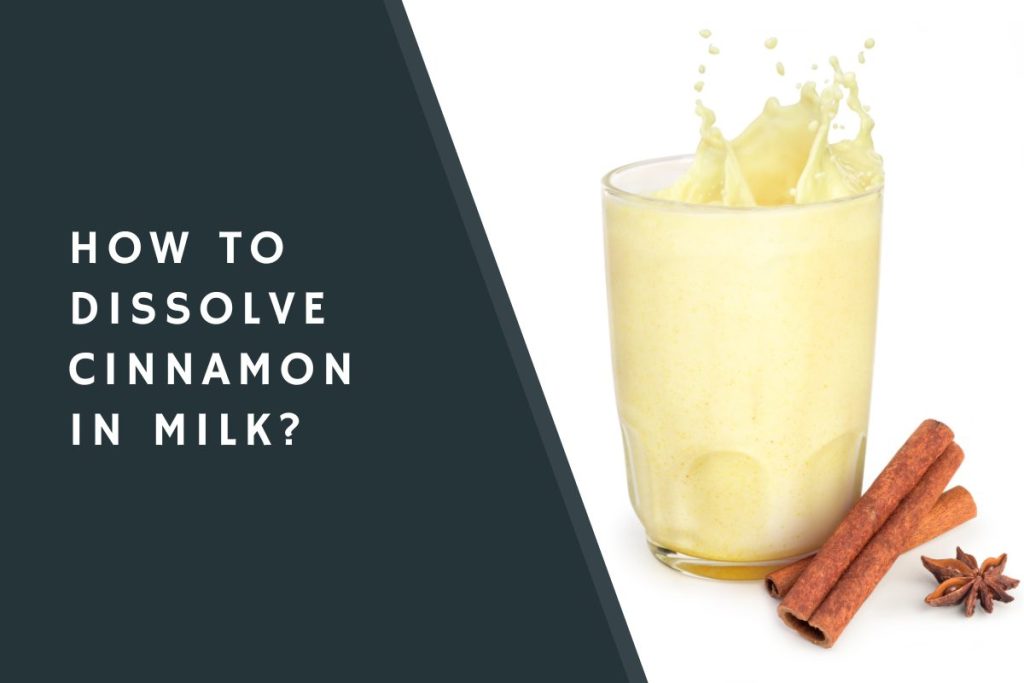Cinnamon is a popular spice that is commonly used in cooking and baking. It has a warm, sweet, and slightly woody flavor that can enhance the taste of many dishes.
One way to enjoy the flavor of cinnamon is by dissolving it in milk. This creates a rich, creamy, and aromatic drink that can be enjoyed hot or cold.
How to Dissolve Cinnamon in Milk?
When mixing cinnamon and milk, keep the cinnamon dry. This will help to prevent burning the cinnamon’s flavor. The milk should be allowed to boil before mixing. When adding the cinnamon, make sure the mixture doesn’t boil again. The cinnamon will dissolve into the milk.
In this article, we will discuss how to dissolve cinnamon in milk and provide some tips and variations to try.

See Also: How to Dissolve Cinnamon in Coffee?
How to Dissolve Cinnamon in Milk? – Method
If you would like to dissolve cinnamon in milk the following guide will help you to dissolve cinnamon in milk:
Step 1: Choosing the Right Milk
The first step in dissolving cinnamon in milk is to choose the right type of milk. There are several options to choose from, including cow’s milk, goat’s milk, almond milk, and soy milk.
Each type of milk has its own unique flavor and nutritional profile, so you can choose the one that best suits your taste and dietary needs.
Cow’s milk is the most common type of milk used for dissolving cinnamon. It is rich in protein, calcium, and other nutrients, and has a creamy, neutral flavor that pairs well with the warm, sweet flavor of cinnamon.
Goat’s milk is another option that is similar to cow’s milk in terms of flavor and nutritional profile.
It is slightly sweeter and has a slightly tangy taste, which can add an interesting twist to the flavor of the cinnamon milk.
Almond milk and soy milk are alternative milks that are suitable for those who are lactose intolerant or following a plant-based diet.
Almond milk is made from ground almonds and water, and has a nutty, slightly sweet flavor. Soy milk is made from soybeans and water, and has a slightly beany flavor.
Both of these milks are lower in calories and fat compared to cow’s milk, but they may not be as creamy or rich.
Step 2: How to Dissolve Cinnamon in Milk
There are several methods for dissolving cinnamon in milk, and the one you choose will depend on the type of milk you are using and the consistency you desire. Here are three methods to try:
Method 1: Stovetop This is the most traditional method for dissolving cinnamon in milk. To start, heat the milk in a saucepan over medium heat until it is hot but not boiling.
Add the desired amount of cinnamon to the milk, stirring constantly to ensure that it is evenly distributed.
You can adjust the amount of cinnamon to your taste, but a good starting point is to use 1/4 to 1/2 teaspoon of cinnamon per cup of milk.
Continue stirring the milk until the cinnamon is fully dissolved and the milk is hot and steamy.
Remove the saucepan from the heat and strain the cinnamon milk through a fine-mesh sieve to remove any undissolved cinnamon bits. Serve the cinnamon milk hot or cold, as desired.
Method 2: Microwave If you don’t have a stove or want a quicker method, you can dissolve cinnamon in milk using the microwave.
To start, place the desired amount of milk in a microwave-safe mug or measuring cup. Add the desired amount of cinnamon and stir to combine.
Microwave the milk on high power for 1 minute, then stir again to ensure that the cinnamon is evenly distributed.
If the cinnamon has not fully dissolved, microwave the milk for an additional 30 seconds.
Repeat this process until the cinnamon is fully dissolved. Strain the cinnamon milk through a fine-mesh sieve if needed, and serve hot or cold.
Method 3: Blender If you want creamy, frothy cinnamon milk, you can use a blender to dissolve the cinnamon. To start, combine the desired amount of milk and cinnamon in a blender.
Blend on high speed until the cinnamon is fully dissolved and the milk is smooth and creamy. This method works best with cow’s milk or goat’s milk, as alternative milks may not blend as smoothly.
You can also add other ingredients to the blender, such as sweeteners, spices, or flavors, to customize the taste of your cinnamon milk.
Step 3: Tips and Variations
Here are some tips and variations to try when making cinnamon milk:
- To add a little extra sweetness to your cinnamon milk, you can add a teaspoon or two of honey, maple syrup, or agave nectar to the milk as it heats up. You can also use a flavored sweetener, such as vanilla syrup or caramel sauce, for a unique twist.
- If you want to add a little extra depth and complexity to the flavor of your cinnamon milk, you can try adding a pinch of ground cloves, cardamom, or nutmeg to the milk as it heats up. These spices have a warm, aromatic flavor that complements the flavor of cinnamon.
- If you want to make your cinnamon milk extra creamy, you can try adding a splash of heavy cream or coconut milk to the milk as it heats up. This will give the milk a richer, velvety texture.
- For a cold, refreshing version of cinnamon milk, you can try making a cinnamon milk smoothie. To do this, combine cold milk, frozen fruit, and cinnamon in a blender and blend until smooth. You can add sweeteners or other flavors as desired.
- For a fun twist on cinnamon milk, you can try making a spicy version by adding a pinch of cayenne pepper or chili flakes to the milk as it heats up. This will give the milk a spicy kick that pairs well with the warm, sweet flavor of cinnamon.
Step 4: Health Benefits of Cinnamon
In addition to its delicious flavor, cinnamon has a number of potential health benefits. Here are a few reasons why you might want to include cinnamon in your diet:
- Cinnamon is a good source of antioxidants, which are compounds that protect the body’s cells from damage caused by free radicals.
- Cinnamon has anti-inflammatory properties, which may help to reduce inflammation in the body and reduce the risk of chronic diseases such as heart disease and diabetes.
- Cinnamon has been shown to have blood-sugar-lowering effects, which may be helpful for people with diabetes or at risk of developing diabetes.
- Cinnamon may also have cholesterol-lowering effects, which may help to reduce the risk of heart disease.
It’s important to note that more research is needed to fully understand the health benefits of cinnamon, and it is not recommended to consume large amounts of cinnamon on a regular basis.
does cinnamon dissolve in milk?
Cinnamon is not soluble in milk, but it can be dispersed in milk with the help of a whisk or blender.
When cinnamon is added to milk, it may initially float on the surface or settle to the bottom, but it can be mixed into the milk with a little bit of stirring or blending.
However, if you are looking to create smooth cinnamon milk, you may want to consider using cinnamon extract or a cinnamon-flavored syrup, as these are more likely to dissolve completely in milk.
Conclusion
Dissolving cinnamon in milk is a simple and delicious way to enjoy the warm, sweet, and aromatic flavor of cinnamon.
Whether you prefer cow’s milk, goat’s milk, almond milk, or soy milk, there is a method for dissolving cinnamon in milk that will suit your needs.
With a few tips and variations, you can customize your cinnamon milk to your taste and dietary needs.
In addition to its delicious flavor, cinnamon has a number of potential health benefits, making it a tasty and nutritious choice for your drinks and meals.
I hope this blog post is helpful for you in understanding how to dissolve cinnamon in milk.
Read Also: Can Cinnamon Sticks Go Bad? , home emma s travel tales
I am an accomplished tech writer with a passion for simplifying complex technology concepts. With a background in Tech, James has dedicated their career to making the intricacies of the digital world accessible to a broad audience.








